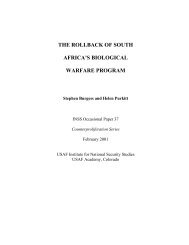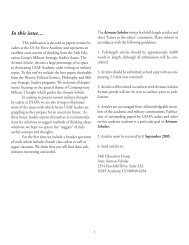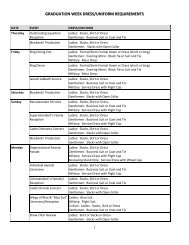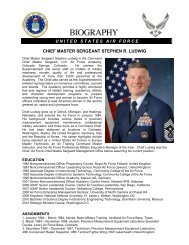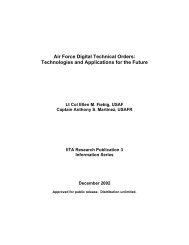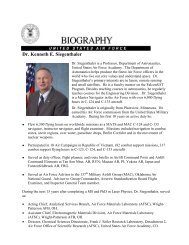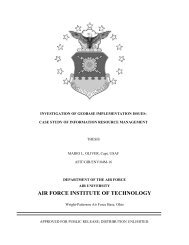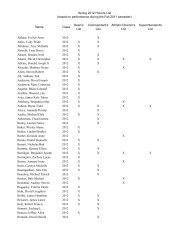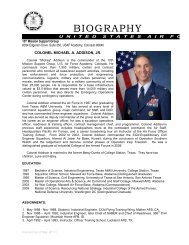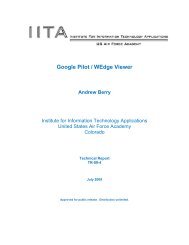Heating Analysis of Falcon Launch VII - Berger.pdf - United States ...
Heating Analysis of Falcon Launch VII - Berger.pdf - United States ...
Heating Analysis of Falcon Launch VII - Berger.pdf - United States ...
You also want an ePaper? Increase the reach of your titles
YUMPU automatically turns print PDFs into web optimized ePapers that Google loves.
<strong>Heating</strong> <strong>Analysis</strong> <strong>of</strong> <strong>Falcon</strong> <strong>Launch</strong> <strong>VII</strong><br />
Andrea V. <strong>Berger</strong> 1 and Kenneth I. Bull 2<br />
<strong>United</strong> <strong>States</strong> Air Force Academy, USAF Academy, Colorado, 80841<br />
The <strong>Falcon</strong>LAUNCH program at the Air Force Academy is in its seventh<br />
year, designing the seventh rocket in the <strong>Falcon</strong>LAUNCH series. This rocket is the<br />
first two-stage rocket in the series including a boost phase and a non-boosted dart. It<br />
is expected to go hypersonic, another first for the program. This speed introduces a<br />
new thermal pr<strong>of</strong>ile. This paper outlines the resulting thermal analysis <strong>of</strong> the dart<br />
nose tip down through a portion <strong>of</strong> the body. This analysis was then used to estimate<br />
temperatures through the rest <strong>of</strong> the body. The thermal approach used for<br />
analyzing missile nose cones as outlined in the book Tactical Missile Design was<br />
used as a basis to develop analytical tools for the program. It uses the flight pr<strong>of</strong>ile<br />
<strong>of</strong> the dart including its speed, altitude, and the corresponding free stream velocity<br />
and temperature combined with the specific heat, thickness, and density <strong>of</strong> the<br />
material used to calculate the skin temperature <strong>of</strong> the nose cone. The temperatures<br />
past the nose tip are found using an iterative process where the distance from the<br />
nose tip is varied. SolidWorks COSMOSFlow was used to find the steady state<br />
conditions, and subsequently, a ratio between the steady state temperature and the<br />
heat concentrations. This ratio was applied to the time variant model to estimate the<br />
temperature at the heat concentrations. The ratio is a conservative estimate because<br />
the ratio is calculated at steady state and during the flight regime, it will never reach<br />
steady state conditions. The data calculated was validated by comparing it to a<br />
similar flight pr<strong>of</strong>ile.<br />
Nomenclature<br />
Ts = stagnation temperature<br />
Tf = freestream temperature<br />
r = recovery factor<br />
MP = Mach number in the corresponding phase<br />
Q = heat<br />
ρf = freestream density<br />
M = Mach number<br />
d = distance from nose cone<br />
Dt/dt = temperature change across wall<br />
c = heat capacity<br />
ρm = density <strong>of</strong> material<br />
tw = thickness <strong>of</strong> wall<br />
T = skin temperature<br />
Ti = initial skin temperature<br />
t = time at the speed and altitude<br />
I. Introduction<br />
<strong>Falcon</strong>LAUNCH is a senior capstone project for undergraduate Astronautical Engineering majors at the <strong>United</strong><br />
<strong>States</strong> Air Force Academy (USAFA). The program allows undergraduates to design, build, analyze, test, and launch<br />
1<br />
Cadet, DFAS, P.O. Box 4388, Student.<br />
2<br />
Cadet, DFAS, P.O. Box 2739, Student.<br />
1<br />
American Institute <strong>of</strong> Aeronautics and Astronautics
a rocket with a Department <strong>of</strong> Defense payload. It is made up <strong>of</strong> 23 senior cadets with 7 faculty mentors. This is the<br />
seventh year in the program, each year a new rocket is produced and launched. The rocket design this year features a<br />
two stage boosted dart design where the second stage is inert. The objective <strong>of</strong> the rocket is to reach space and<br />
gather information on the effect <strong>of</strong> winglets on rocket fins going faster than Mach 4. It will be the first rocket in the<br />
program with two stages. This created several interesting issues for analysis as the near-hypersonic environment<br />
presents many heating and loading difficulties. Future rockets in the program are expected to go hypersonic, so an<br />
analysis tool will be needed for a fully hypersonic flight pr<strong>of</strong>ile as well. The program decided to attempt to create an<br />
in-house thermal analysis tool. With a starting point in Tactical Missile Design and some conservative thermal<br />
analysis provided by Alliant Techsystems, Inc. (ATK) and <strong>United</strong> <strong>Launch</strong> Alliance (ULA) as a method <strong>of</strong><br />
validation, a tool was created in Excel for this purpose. The mathematical basis behind the tool is explored in this<br />
report.<br />
II. Description <strong>of</strong> Tools<br />
Several tools where used calculated and validate the thermal analysis <strong>of</strong> <strong>Falcon</strong> <strong>Launch</strong> <strong>VII</strong><br />
A. COSMOSflow<br />
COSMOSflow is a computational fluid dynamics add-on provided by SolidWorks. It has the capabilities to<br />
model high Mach number, as well as creating steady state and time dependent models. Models may be run using a<br />
variety <strong>of</strong> initial conditions allowing for the ability to choose altitudes and speeds, different fluids besides air may<br />
also be used. A problem that was encountered was COSMOSflow requires a large amount <strong>of</strong> computational<br />
resources in order to be run properly. Time dependent models were impossible to run on our systems because it was<br />
estimated to run for up to a month at the highest quality mesh setting. Another problem was the computer used did<br />
not have sufficient memory to open the results <strong>of</strong> a high mesh model. The solution to these problems were to run<br />
each simulation at steady state conditions with a lower quality mesh for a timely turnaround <strong>of</strong> three days. This<br />
provided the most accurate model that did not use all <strong>of</strong> the computer’s resources, as well as providing a quick<br />
results.<br />
B. <strong>United</strong> <strong>Launch</strong> Alliance<br />
<strong>United</strong> <strong>Launch</strong> Alliance (ULA) provided thermal analysis using MINIVER to perform an aero heating<br />
assessment. They validated this assessment with FLUENT CFD simulation and used SINDA to performance a<br />
detailed time phased thermal analysis to calculate the temperature distributions. Their simulations and analysis were<br />
completed assuming constant Mach 5 flight and constant altitude for 300 seconds. The resulting data is extremely<br />
conservative.<br />
C. <strong>Falcon</strong>LAUNCH VI Data<br />
In 2007, AFRL provided thermal analysis for <strong>Falcon</strong>LAUNCH VI. That rocket had a similar geometry with a<br />
conical nose cone, and thermal data was provided for the nose tip up to Mach 5. So, this data can be used for<br />
comparison and validation.<br />
2<br />
American Institute <strong>of</strong> Aeronautics and Astronautics
D. Tactical Missile Design<br />
Tactical Missile Design (TMD) 1 is a text written by Eugene L. Fleeman describing the design process for<br />
missiles. It includes a section on how to predict the temperatures <strong>of</strong> the nose cone and body. The book also comes<br />
with a CD, which has a spreadsheet that includes calculations for the maximum temperature. The TMD method<br />
starts with calculations <strong>of</strong> a launch phase where a missile is fired from earth or a plane. Then, it has a boost phase<br />
allowing the missile to reach the desired trajectory. Next it has a cruise phase where thrust is maintained to keep the<br />
missile on its flight path, and finally it has a coast phase as the missile coasts in to detonate on its target. Each <strong>of</strong><br />
these phases is necessary for a missile, but the spreadsheet did not allow any phase to be turned <strong>of</strong>f to meet rocket<br />
needs, which are only launch for the purposes <strong>of</strong> the <strong>Falcon</strong>LANCH <strong>VII</strong> rocket. Thus, this model was not accurate<br />
enough to use by itself and was modified significantly to fit the needs <strong>of</strong> the rocket program.<br />
III. Thermal <strong>Analysis</strong> Tool<br />
A. Tactical Missile Design Beginnings<br />
TMD is a missile design text, so in its thermal analysis section it focuses on launch, boost, cruise, and coast skin<br />
temperatures <strong>of</strong> the nose cone and the body <strong>of</strong> the craft. On the rocket, only the launch and boost phases are needed.<br />
This is particularly true for <strong>Falcon</strong>LAUNCH <strong>VII</strong> because the rocket deconstructs at apogee deploying a recoverable<br />
structure, so the temperature <strong>of</strong> the rocket structure no longer matters. As written, the spreadsheet provided on the<br />
CD accompanying the text would not operate without information for all <strong>of</strong> the four phases. However, it provided<br />
the core methodology and mathematics which lead to the development <strong>of</strong> the tool used for <strong>Falcon</strong>LAUNCH <strong>VII</strong>.<br />
B. Basic Mathematical Functions<br />
The basic process is to find the stagnation temperature, then the heat, then the heat transfer at the wall, and<br />
finally the skin temperature. This process requires flight pr<strong>of</strong>ile information including the freestream temperature<br />
and density, time, and Mach number at different times. It also required information about the material used. This<br />
process is efficient, but ineffective as used in TMD because it finds these based on a short boost phase and long<br />
glide phase at constant freestream density and speed. However, the equations as shown provided a basis to develop<br />
a useful tool.<br />
The stagnation temperature is found using the freestream temperature as shown in equation 1 1 .<br />
2<br />
Ts Tf<br />
[ 1<br />
. 2(<br />
r)(<br />
M P)<br />
]<br />
(eq. 1)<br />
Ts: stagnation temperature<br />
Tf: freestream temperature<br />
r: recovery factor<br />
MP: Mach number in the corresponding phase<br />
The heat, Q, is dependent on the distance from the nose tip and freestream density as shown in equation 2 1 .<br />
2.<br />
8<br />
M<br />
0.<br />
2<br />
d (eq. 2)<br />
Q: heat<br />
ρf: freestream density<br />
M: Mach number<br />
d: distance from nose cone<br />
0 . 8<br />
Q 345(<br />
f )<br />
With the heat determined, the temperature change across the wall <strong>of</strong> the body can be found according to equation 3 1 .<br />
c<br />
Dt Q<br />
<br />
dt <br />
m w t<br />
(eq. 3)<br />
Dt/dt: temperature change across wall<br />
c: heat capacity<br />
ρm: density <strong>of</strong> material<br />
tw: thickness <strong>of</strong> wall<br />
3<br />
American Institute <strong>of</strong> Aeronautics and Astronautics
At this point, the skin temperature is found using equation 4 1 .<br />
Qt<br />
c<br />
m ( Ts<br />
Ti<br />
)<br />
s<br />
T Ts<br />
( Ti<br />
T<br />
)<br />
(eq. 4)<br />
T: skin temperature<br />
Ti: initial skin temperature<br />
t: time at the speed and altitude<br />
Here, the spreadsheet and book end their contributions to the rocket thermal analysis as it takes a departure into the<br />
realm <strong>of</strong> straight and level flight. However, the equations presented are vital to the tool developed for the rocket<br />
needs.<br />
C. Integration<br />
A new spreadsheet was developed to fit the needs <strong>of</strong> the rocket program better. The program needed a tool to be<br />
user friendly for students. It also needs to do calculations where Mach, time, and distance from the nose tip are<br />
simultaneously variable. Excel was chosen as the most user-friendly interface, and a spreadsheet developed that does<br />
the necessary calculations concurrently.<br />
The first tab <strong>of</strong> the spreadsheet is definitions <strong>of</strong> variables used. The second is where the flight pr<strong>of</strong>ile including<br />
Mach number, speed, altitude, freestream density and freestream temperature are input for reference throughout the<br />
workbook. This tab also houses the information about the material used including its specific heat, the wall<br />
thickness, material density, and recovery factor. The third tab is a succinct output <strong>of</strong> results which will be described<br />
later. The fourth tab begins the section <strong>of</strong> calculation tabs. It first finds the stagnation or recovery temperature using<br />
equation 1. Next, it finds the heat using equation 2, followed by the change in temperature at the wall using equation<br />
3, and finally the skin temperature using equation 4. The calculation tabs calculate the temperature at the desired<br />
distance from the tip <strong>of</strong> the nose cone, with each subsequent tab finding the temperature some distance farther away<br />
from the tip. Each individual tab calculates the temperatures with varying speeds matching the flight pr<strong>of</strong>ile and<br />
iterates to find the temperature as the Mach increases with the corresponding time increases as well. This creates a<br />
way to track the changes in temperature as the rocket ascends as well as the changes in temperature down the body<br />
tube simultaneously. Each calculation tab features a graph with altitude vs. Mach number and skin temperature vs.<br />
Mach number for quick analysis. The results are summarized in the output tab, tab 3, where the maximum<br />
temperatures found on each sheet and graphed against the distance from the nose tip for a full picture <strong>of</strong> the<br />
temperature pr<strong>of</strong>ile at the hottest time.<br />
D. Output Data<br />
The results show a maximum nose tip temperature <strong>of</strong> 1,664 o F with body temperatures decreasing from 357 o F to<br />
134 o F with distance away from the tip as shown in table 1 and figure 1.<br />
Table 1: Results<br />
Distance from tip Maximum Temperature<br />
ft ˚F<br />
0.00000008 1664.601795<br />
0.001 357.5283292<br />
0.005 280.19313<br />
0.01 253.512305<br />
0.03 217.8667144<br />
0.05 203.6990196<br />
0.08 191.8475168<br />
0.1 186.5889914<br />
0.2 171.6402236<br />
0.3 163.7896882<br />
0.4 158.5857898<br />
0.5 154.746693<br />
0.6 151.7323487<br />
0.7 144.8939403<br />
0.8 142.9308945<br />
0.9 141.2416654<br />
1 139.7634311<br />
1.1 138.4523711<br />
4<br />
American Institute <strong>of</strong> Aeronautics and Astronautics
1.2 137.2767703<br />
1.3 136.2129765<br />
1.4 135.2429063<br />
1.5 134.3524417<br />
Figure 1: Output Chart<br />
The maximum temperatures occurs around 5.5 seconds into the launch time exactly as predicted as this is the end <strong>of</strong><br />
the boosted phase <strong>of</strong> the rocket. The results led to important decisions on materials and coatings for the project.<br />
The design impacts <strong>of</strong> this thermal analysis are summarized in section V.<br />
IV. Validation<br />
A. Comparison to COSMOSflow 4<br />
Due to restrictions <strong>of</strong> our equipment, COSMOSflow could only be simulated as a steady state system. The<br />
results from the COSMOSflow simulations were more extreme then <strong>Falcon</strong>LAUNCH <strong>VII</strong> would experience in<br />
flight. Because <strong>of</strong> this, COSMOSflow could not be relied on to give accurate data, but it could be used to identify<br />
hot spots <strong>of</strong> the body <strong>of</strong> the rocket that the spreadsheet could not identify. For example, hot spots were discovered<br />
on the interstage from where the shockwaves from the dart fins impacted the interstage. To estimate the hotspots, a<br />
ratio was determined based on the highest temperature in the hot spot to the temperature surrounding the hot spot.<br />
This ratio could then be applied to the temperatures calculated by the spreadsheet to determine the maximum<br />
temperature that <strong>Falcon</strong> <strong>Launch</strong> <strong>VII</strong> would experience. The ratio at steady state is higher than the ratio would be<br />
after a short period <strong>of</strong> time, but this allows for our estimates to remain conservative.<br />
B. Comparison to <strong>United</strong> <strong>Launch</strong> Alliance<br />
The data provided by ULA is a very conservative estimate <strong>of</strong> the thermal pr<strong>of</strong>ile. It is not as detailed as the tool<br />
developed at USAFA as it assumes constant freestream density and Mach number for 300 seconds. Because the 300<br />
seconds are not correlated with changes in altitude or speed, the resulting data is very conservative. The ULA<br />
method provided data showing the maximum body temperature <strong>of</strong> 1150 o F after 300 seconds, but is somewhere<br />
5<br />
American Institute <strong>of</strong> Aeronautics and Astronautics
etween 200 o F and 300 o F after 5 seconds, the predicted maximum heating point 2 . The results are shown in figure 2.<br />
These results validate the results found through the USAFA developed tool. The ULA results are summarized in<br />
figure 2 2 .<br />
Temperature, deg F<br />
1400<br />
1200<br />
1000<br />
800<br />
600<br />
400<br />
200<br />
<strong>Falcon</strong><strong>Launch</strong> Temperature<br />
with fin mount<br />
0<br />
0 50 100 150 200 250 300<br />
Time, sec<br />
Figure 2: ULA Results<br />
C. Comparison to <strong>Falcon</strong>LAUNCH VI<br />
<strong>Falcon</strong>LAUNCH VI data also validates the <strong>Falcon</strong>LAUNCH <strong>VII</strong> tool. AFRL provided a thermal pr<strong>of</strong>ile with a<br />
maximum temperature <strong>of</strong> 1,940 o F at Mach 5.35 3 . This is slightly higher than the USAFA estimate, but is similar<br />
enough to validate the resulting data is a good approximation <strong>of</strong> what can be expected.<br />
V. Design Contributions<br />
The thermal data gained from the analysis was integral in making several design decisions. The maximum<br />
heating is expected in two areas according to the hot spots found in COSMOSflow: nose cone and interstage 4 . The<br />
estimates for the temperature on the nose cone varied depending on the method, so Inconel 718 was chosen as the<br />
nose cone material. This material maintained structural integrity past the AFRL estimate <strong>of</strong> 1,940 o F. This ensured<br />
that even if the USAFA estimate is low, the rocket will not fail due to heating <strong>of</strong> the nose cone. The interstage was<br />
coated with an ablative cork to keep the steel underneath from experiencing the extreme heating. This measure<br />
ensured the program did not trade structural integrity for thermal properties. Other coatings were considered for the<br />
body tube so that a more available material could be used, but ultimately the thermal analysis proved the steel<br />
chosen would be successful in the heating environment. While there are not temperature stain gauges on the rocket,<br />
the hardware can be recovered to validate the materials chosen were effective and the estimates were correct. It has<br />
been proposed that the next rocket in the program be wired to record the actual thermal data from flight to further<br />
validate the model.<br />
6<br />
American Institute <strong>of</strong> Aeronautics and Astronautics<br />
Dart Body<br />
Dart Fin<br />
Fin Tab<br />
Booster Fin
VI. Conclusion<br />
The thermal analysis tool developed for in-house thermal calculations for the USAFA <strong>Falcon</strong>LAUNCH program<br />
is accurate based on comparison validation for the nose tip through the body. Design decisions made based on the<br />
results <strong>of</strong> the analysis were integral to the program. Having this tool has made a significant impact on the ability <strong>of</strong><br />
the program to make informed decisions and move forward to launch with confidence. Further, with this tool in<br />
hand, <strong>Falcon</strong>LAUNCH <strong>VII</strong>I can improve their rocket design and ultimately do thermal tests on launch to further<br />
validate the tool. Testing will be more credible pro<strong>of</strong> <strong>of</strong> the tool’s accuracy. While this tool alone provides thermal<br />
analysis for the components <strong>of</strong> the rocket most susceptible to thermal failure, it also sets up for the future when<br />
cadets expand upon the spreadsheet by adding thermal analysis for fins and other parts <strong>of</strong> the rocket. It can also be<br />
combined with another tool currently in house which calculates the temperature on the inside <strong>of</strong> the body tube based<br />
on heating on the outside. These tools together would provide an all-in-one comprehensive thermal analysis. This<br />
tool has laid the groundwork for future endeavors into a previously impossible task for the program.<br />
Acknowledgments<br />
Thanks to <strong>United</strong> <strong>Launch</strong> Alliances for providing us with a comprehensive CFD analysis <strong>of</strong> <strong>Falcon</strong>LAUNCH<br />
<strong>VII</strong>.<br />
Thanks to Air Force Research lab for providing CRD analysis to <strong>Falcon</strong>LAUNCH VI which was integral to this<br />
year’s endeavors.<br />
References<br />
1 Fleeman, Eugene L. Tactical Missile Design. 2nd ed. Reston, VA: AIAA, 2006. Pages 162-170.<br />
2 Chern, S. <strong>Falcon</strong>LAUNCH <strong>VII</strong> Thermal <strong>Analysis</strong>. Tech. ULA, 2009.<br />
3 <strong>Falcon</strong>LAUNCH VI Thermal <strong>Analysis</strong>. Tech. AFRL, 2007.<br />
4 SolidWorks COSMOSflow, SolidWorks Academic Edition 2008 SP4.0.<br />
7<br />
American Institute <strong>of</strong> Aeronautics and Astronautics




